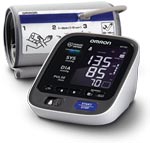While sodium does not affect blood glucose levels, it has an effect on blood pressure. The combination of diabetes and high blood pressure increases your risk of heart attack, stroke, kidney disease and eye problems. Carefully reading food labels helps you lower your daily salt intake.
- Your blood pressure is the force of blood flow inside your blood vessels. When blood moves through your vessels with excessive force, it leads to high blood pressure. Your heart is working harder and the risk of diabetes problems increases.
The American Diabetes Association recommends a lower blood pressure target for people with diabetes than the general public. Try to maintain a blood pressure level of less than 130/80 mmHg. Blood pressure monitors help you determine whether your blood pressure is on target.
- Our bodies need salt but we typically get too much. Your kidneys pass excess salt to the urine. If salt levels are very high, the kidneys are unable to keep up. Salt ends up in your bloodstream and attracts more water into your blood. This increases blood volume which raises your blood pressure.
- High blood pressure puts people with diabetes at risk for heart attack, stroke, eye problems and kidney disease because of its impact on your heart, kidneys and water levels.
- Limiting your salt intake lowers your blood pressure. Your salt intake should be 1500 mg a day, which should be broken down into 500 mg per meal.
- Salt free mean foods contain less than 5 mg of sodium per labeled serving and with no sodium chloride. Low salt means the food choice has 140 mg or less per serving. Very low sodium has 35 mg or less of salt per serving. Reduced sodium foods have 25 percent less grams of salt per 100g. Light in sodium means the sodium is reduced by at least 50 percent. No salt added does not mean food is naturally sodium-free so check labels carefully.
- While some foods taste salty, others might not. Be aware of unexpected high sodium foods such as cottage cheese, soups, dressings and luncheon meats. Review labels carefully to check salt levels before buying these tricky choices.
- Typical table salt is refined down to sodium chloride and conditioned with chemicals, dextrose (sugar) and potassium iodide. Whole foods and unprocessed sea salt contain trace elements of minerals with no additives.
- Salt alternatives and substitutes are available but may not be a healthy choice for everyone. Many salt substitutes contain potassium chloride rather than sodium chloride. Excessive potassium is harmful for people with kidney problems who cannot rid their bodies of it. If you have kidney disease, check with a medical professional before using salt alternatives.
- There are a variety of delicious low sodium choices including unsalted nuts, milk, fruits and steamer vegetables.
Your body needs salt for cleansing, healing and fluid balance but often gets too much. Read labels to lower your daily salt intake and reduce the risk of high blood pressure and related diabetes health problems.
 The American Diabetes Association recommends a lower blood pressure target for people with diabetes than the general public. Try to maintain a blood pressure level of less than 130/80 mmHg.
The American Diabetes Association recommends a lower blood pressure target for people with diabetes than the general public. Try to maintain a blood pressure level of less than 130/80 mmHg. 





Leave A Comment